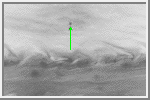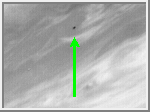
Jupiter XIV - 1979J2
Thebe [THEE-bee] is the fourth known satellite of Jupiter. Thebe was a nymph and the daughter of the river god Asopus. Thebe rotates synchronously around Jupiter. Very little is known about this moon.
| Thebe Statistics | |
|---|---|
| Discovered by | Stephen Synnott |
| Date of discovery | 1979 |
| Mass (kg) | 7.77e+17 |
| Mass (Earth = 1) | 1.3002e-07 |
| Radius (km) | 55x45 |
| Radius (Earth = 1) | 8.6234e-03 |
| Mean density (gm/cm^3) | 1.5 |
| Mean distance from Jupiter (km) | 221,895 |
| Rotational period (days) | 0.674536 |
| Orbital period (days) | 0.674536 |
| ;Mean orbital velocity (km/sec) | 23.93 |
| Orbital eccentricity | 0.0183 |
| Orbital inclination (degrees) | 1.0659 |
| Escape velocity (km/sec) | 0.0434 |
| Visual geometric albedo | 0.05 |
| Magnitude (Vo) | 15.7 |
 Two Galileo Views of Thebe
Two Galileo Views of Thebe
These two images of the Jovian moon Thebe were taken by Galileo's
solid state imaging system in November 1996 and June 1997, respectively.
North is approximately up in both cases. Thebe, whose longest dimension
is approximately 116 kilometers (72 miles) across, is tidally locked
so that the same side of the satellite always points towards Jupiter,
similar to how the near side of our own Moon always points toward Earth.
In such a tidally locked state, one side of Thebe always points
in the direction in which Thebe moves as it orbits about Jupiter.
This is called the "leading side" of the moon and is shown at the left.
The image on the right emphasizes the side of Thebe that faces away
from Jupiter (the "anti-Jupiter" side). Note that there appear to be
at least three or four very large impact craters on the satellite
-- very large in the sense that each of these craters is roughly
comparable in size to the radius of Thebe.
(Courtesy NASA/JPL)
 Best images yet of Thebe, Amalthea and Metis
Best images yet of Thebe, Amalthea and Metis
These images of the inner Jovian moons Thebe,
Amalthea, and Metis (left to right) are the
highest-resolution images ever obtained of these small, irregularly
shaped satellites. The images resolve surface features as small as 2 kilometers
(about 1.2 miles) across for Thebe; 2.4 kilometers (about 1.5
miles) across for Amalthea, and 3 kilometers (about
1.9 miles) across for Metis.
The prominent impact crater on Thebe is about 40 kilometers
(about 25 miles) across and has been given the provisional name Zethus.
(Courtesy NASA/Cornell University)
 Jupiter Small Satellite Montage
Jupiter Small Satellite Montage
This image is A montage of images of the small inner moons of Jupiter from
the camera onboard NASA's Galileo spacecraft shows the best
views obtained of these moons.
The top two images show the moon Thebe.
Thebe rotates by
approximately 50 degrees between the time these two images
were taken, so that the same prominent impact crater
is seen in both views; this crater, which has been given
the provisional name Zethus, is near the point on Thebe
that faces permanently away from Jupiter.
The next two images show the moon Amalthea; they were taken
with the Sun directly behind the observer, an alignment that
emphasizes patterns of intrinsically bright or dark
surface material. The third image from the top is a view of
Amalthea's leading side, the side of the moon that 'leads'
as Amalthea moves in its orbit around Jupiter. This image
looks 'noisy' because it was obtained serendipitously during
an observation of the Jovian satellite Io (Amalthea and Io
shared the same camera frame but the image was exposed
for bright Io rather than for the much darker Amalthea).
The fourth image from the top emphasizes prominent 'spots'
of relatively bright material that are located near the point on
Amalthea that faces permanently away from Jupiter. The bottom
image is a view of the tiny moon Metis.
(Courtesy NASA/Cornell University)
 Discovery Image
Discovery Image
This is one of the discovery images (FDS 16383.54) of Thebe.
It was taken by the Voyager 1 spacecraft 4 hours 26 minutes
before the closest approach to Jupiter. This image is a wide
angle picture taken at a range 4.3x105 kilometers. The dark circular
disk is the shadow of Thebe and not the actual planet. Once the
shadow images were analyzed, Thebe was located on several other
images.
(Credit: Calvin J. Hamilton)
 Thebe
Thebe
This image of Thebe (FDS 16220.56) was taken by the Voyager 1 spacecraft
on February 27, 1979. Thebe is the small dark dot above the arrow.
(Credit: Calvin J. Hamilton)
![]() Family Portrait of the Small Inner Satellites of Jupiter
Family Portrait of the Small Inner Satellites of Jupiter
These images, taken by Galileo's solid state imaging system between
November 1996 and June 1997, provide the first ever "family portrait"
of the four small, irregularly shaped moons that orbit Jupiter
in the zone between the planet's ring and the larger Galilean satellites.
The moons are shown in their correct relative sizes, with north approximately
up in all cases. From left to right, arranged in order of increasing distance
from Jupiter, are Metis (longest dimension is approximately 60 kilometers or
37 miles across), Adrastea (20 kilometers or 12 miles across), Amalthea
(247 kilometers or 154 miles across), and Thebe (116 kilometers or 72 miles
across). While Amalthea, the largest of these four tiny moons, was imaged
by NASA's two Voyager spacecraft in 1979 with a resolution comparable to what
is shown here, the new Galileo observations represent the first time that
Metis, Adrastea, and Thebe have been seen as more than points of light.
(Courtesy of NASA/JPL)
Synnott, S. P. "1979J2: Discovery of a Previously Unknown Jovian Satellite." Science, Vol 210, 14 November 1980.
Synnott, S. P. "Orbits of the Small Inner Satellites of Jupiter." Icarus 58, 1984.

 Jupiter
Jupiter Amalthea
Amalthea Io
Io